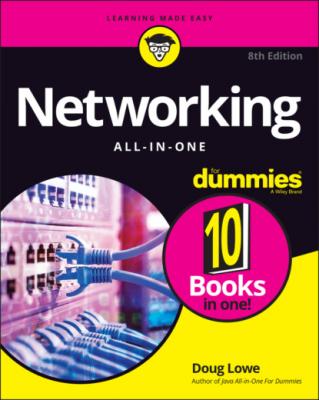Networking All-in-One For Dummies. Doug Lowe
Читать онлайн.| Название | Networking All-in-One For Dummies |
|---|---|
| Автор произведения | Doug Lowe |
| Жанр | Зарубежная компьютерная литература |
| Серия | |
| Издательство | Зарубежная компьютерная литература |
| Год выпуска | 0 |
| isbn | 9781119689058 |
Introducing Some of the Major Cloud Providers
Hundreds, if not thousands, of companies provide cloud services. Most of the cloud computing done today, however, is provided by just a few providers, which are described in the following sections.
Amazon
By far the largest provider of cloud services in the world is Amazon. Amazon launched its cloud platform — Amazon Web Services (AWS) — in 2006. Since then, hundreds of thousands of customers have signed up. Some of the most notable users of AWS include Netflix, Pinterest, and Instagram.
AWS includes the following features:
Amazon CloudFront: A PaaS content-delivery system designed to deliver web content to large numbers of users.
Amazon Elastic Compute Cloud: Also called Amazon EC2. An IaaS system that provides access to raw computing power.
Amazon Simple Storage Service: Also called Amazon S3. Provides web-based data storage for unlimited amounts of data.
Amazon Simple Queue Service: Also called Amazon SQS. Provides a data transfer system that lets applications send messages to other applications. SQS enables you to build applications that work together.
Amazon Virtual Private Cloud: Also called Amazon VPC. Uses virtual private network (VPN) connections to connect your local network to Amazon’s cloud services.
For more information about Amazon Web Services, refer to Book 5, Chapter 4.
Google is also one of the largest providers of cloud services. Its offerings include the following:
G Suite: A replacement for Microsoft Office that provides basic email, word processing, spreadsheet, and database functions via the cloud. G Suite is free to the general public and can even be used free by small business (up to 50 users). For larger businesses, Google offers an advanced version, G Suite for Business. For $5 per month per user, you get extra features, such as 25GB of email data per user, archiving, and advanced options for customizing your account policies.
Google Drive: A cloud-based solution that lets you work with Google cloud data directly from within Microsoft Office applications.
Google App Engine: A PaaS interface that lets you develop your own applications that work with Google’s cloud services.
Google Cloud Print: Allows you to connect your printers to the cloud so that they can be accessed from anywhere.
Google Maps: A Global Information System (GIS).
Microsoft
Microsoft has its own cloud strategy, designed in part to protect its core business of operating systems and Office applications against competition from other cloud providers, such as Google Apps.
The following paragraphs summarize several of Microsoft’s cloud offerings:
Microsoft Office 365: A cloud-based version of Microsoft Office. According to Microsoft’s website, Office 365 provides “anywhere access to cloud-based email, web conferencing, file sharing, and Office Web Apps at a low predictable monthly cost.” For more information, check out www.office365.com.
Windows Azure: A PaaS offering that lets you build websites, deploy virtual machines that run Windows Server or Linux, or access cloud versions of server applications such as SQL Server.For more information about Azure, refer to Book 5, Chapter 3.
Getting Into the Cloud
After you wrap your head around just how cool cloud computing can be, what should you do to take your network toward the cloud? Allow me to make a few recommendations:
Don’t depend on a poor Internet connection. First and foremost, before you take any of your network operations to the cloud, make sure that you’re not dependent on a consumer-grade Internet connection if you decide to adopt cloud computing. Consumer-grade Internet connections can be fast, but when an outage occurs, there’s no telling how long you’ll wait for the connection to be repaired. You definitely don’t want to wait for hours or days while the cable company thinks about sending someone out to your site. Instead, spend the money for a high-speed enterprise-class connection that can scale as your dependence on it increases.
Assess what applications you may already have running on the cloud. If you use Gmail rather than Exchange for your email, congratulations! You’ve already embraced the cloud. Other examples of cloud services that you may already be using include a remote web or FTP host, Dropbox or another file-sharing service, Carbonite or another online backup service, a payroll service, and so on.
Don’t move to the cloud all at once. Start by identifying a single application that lends itself to the cloud. If your engineering firm archives projects when they close and wants to get them off your primary file server but keep them readily available, look to the cloud for a file storage service.
Go with a reputable company. Google, Amazon, and Microsoft are all huge companies with proven track records in cloud computing. Many other large and established companies also offer cloud services. Don’t stake your company’s future on a company that didn’t exist six months ago.
Research, research, research. Pour yourself into the web, and buy a few books. Hybrid Cloud For Dummies, by Judith Hurwitz, Marcia Kaufman, Dr. Fern Halper, and Daniel Kirsch (Wiley), is a good place to start.
Book 2
Understanding Network Protocols
Contents at a Glance
1 Chapter 1: Network Protocols and Standards Understanding Protocols Understanding Standards Seeing the Seven Layers of the OSI Reference Model Following a Packet through the Layers The Ethernet Protocol The TCP/IP Protocol Suite Other Protocols Worth Knowing About
2 Chapter 2: TCP/IP and the Internet What Is the Internet? A Little Internet History TCP/IP
